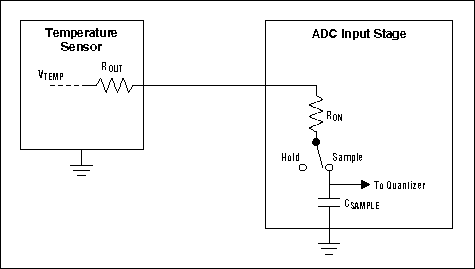Using Analog Temperature Senso
[09-13 17:03:28] 来源:http://www.88dzw.com 控制技术 阅读:8905次
文章摘要:Abstract: Analog temperature sensors are often used with analog-to-digital converters (ADCs). Understanding the interface between the two devices will help the designer achieve better temperature measurement accuracy with these devices. This application note discusses the sensor-ADC interface and ho
Using Analog Temperature Senso,标签:计算机控制技术,工厂电气控制技术,http://www.88dzw.comAbstract: Analog temperature sensors are often used with analog-to-digital converters (ADCs). Understanding the interface between the two devices will help the designer achieve better temperature measurement accuracy with these devices. This application note discusses the sensor-ADC interface and how to get the best results from the components used.
Analog-output temperature sensors are popular because of their low cost, small size, and low power requirements. In many systems that use analog temperature sensors, the sensor's output is measured with an analog-to-digital converter (ADC).
Understanding a few simple concepts will help you in the design of the sensor/ADC interface. In the discussion below, we will use the MAX6605, a low-power analog temperature sensor, to illustrate the concepts.
Source Impedance
Most general-purpose ADCs in widespread use, whether discrete or embedded in a microcontroller, have a simple sample-hold circuit at their inputs. A switch connects the signal source with a sampling capacitor. After a short sampling period, the switch opens. Figure 1 shows a simplified version of an ADC input stage. Note that all ADC input stages are not the same; Figure 1 is shown as a conceptual aid only.
Figure 1. This is a conceptual schematic of an analog temperature sensor driving the input of a sampling ADC. A temperature sensor with excessive output resistance causes errors by preventing the sampling capacitor from charging fully during the sampling period.
For accurate sampling of the input signal, the capacitor must fully charge during the time that the switch is closed. For a 10-bit ADC, this means that the time constant of the total source resistance (including the switch on-resistance) multiplied by the sampling capacitance (say, 10pF) must be less than about 10% of the time that the switch is closed:
(RON + ROUT) x CSAMPLE < 0.1 x TSAMPLEwhere RON is the sampling switch on-resistance, ROUT is the output resistance of the temperature sensor, CSAMPLE is the sample-hold capacitance, and TSAMPLE is time that the sampling switch is closed.
This places a constraint on the value of the source resistance driving the ADC input. Most general-purpose ADCs have maximum source-impedance limits somewhere between 1kΩ and 10kΩ.
Analog temperature sensors have output resistances that range from less than 100Ω to several kΩ; some of the higher-impedance output stages are incompatible with certain ADC inputs. The MAX6605 has a 240Ω output impedance and is compatible with virtually all general-purpose ADCs.
If a temperature sensor has excessive output resistance, connecting a capacitor between the ADC input pin and ground can reduce the effective source impedance and minimize errors. The capacitor should usually be on the order of a thousand times' the value of the sampling capacitor, so a 10nF capacitor is generally sufficient. The time between samples should be long enough to allow the capacitor voltage to approximate the sensor's output voltage to within the required accuracy. Ten time constants should be sufficient for a 10-bit ADC; therefore, for a 1k source resistance and a 10nF capacitor, a period of at least 100µs between conversions should be adequate.
Tag:控制技术,计算机控制技术,工厂电气控制技术,控制技术
《Using Analog Temperature Senso》相关文章
- › 利用液晶的MAXQ微控制器-Using an LCD wit
- › Using Timers in the MAXQ Famil
- › Using Analog Temperature Senso
- › Using the DS87C530/DS5250 Real
- 在百度中搜索相关文章:Using Analog Temperature Senso
- 在谷歌中搜索相关文章:Using Analog Temperature Senso
- 在soso中搜索相关文章:Using Analog Temperature Senso
- 在搜狗中搜索相关文章:Using Analog Temperature Senso
分类导航
最新更新




 当前位置:
当前位置: